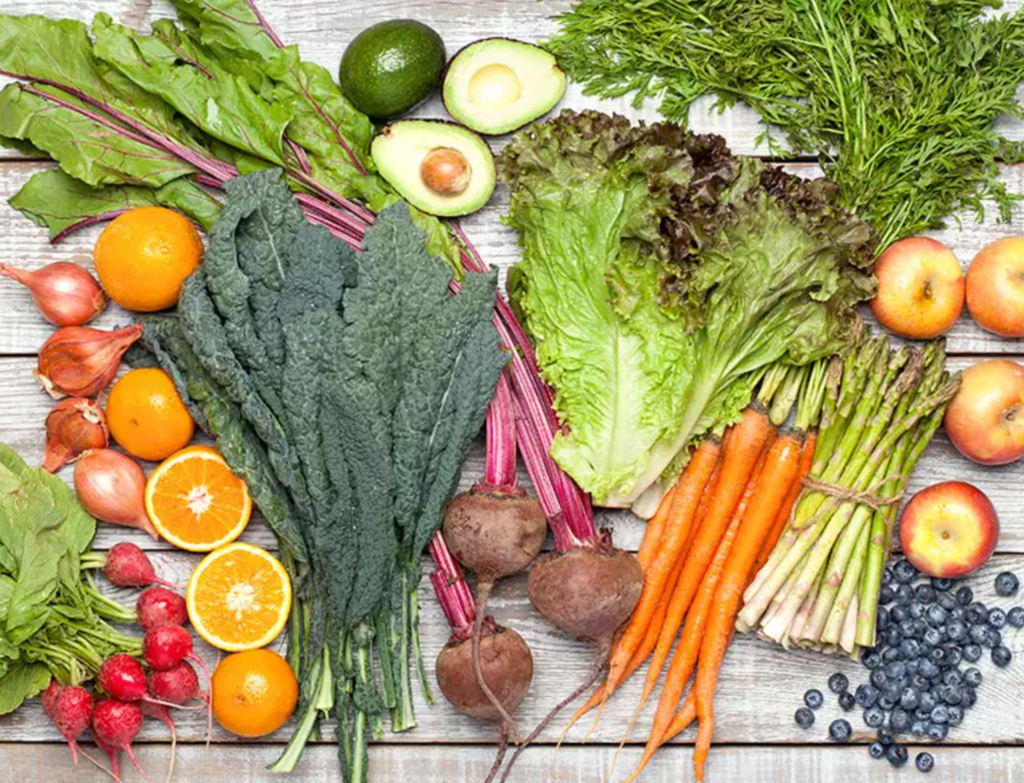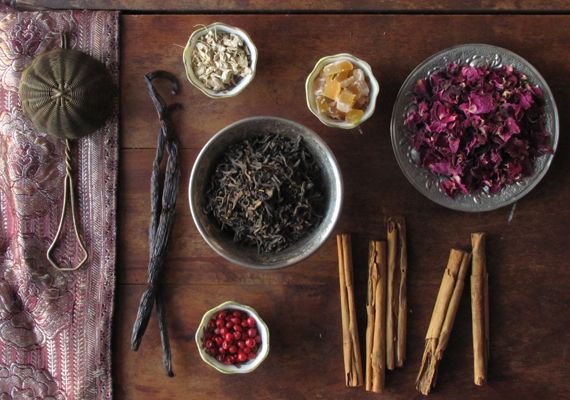The Six Tastes of an Ayurvedic Diet

.
.
.
.
How to create an Ayurvedic diet with the 6 tastes ➤
Using the six tastes in an Ayurvedic diet is both a simple and comprehensive way to support healing and create balance within your body and mind.
.
Everything in the universe is comprised of energy, with an expression of qualities (or gunas) : the weather, the season, an apple or some leafy kale, even a headache or a certain mood.
.
When you tap into the six tastes, the 20 gunas and your heightened awareness, you can use the language and wisdom of Ayurveda to choose what tastes and specific foods or herbs will create the desired effect on your body and mind and avoid others that can aggravate your issues and cause further discomfort.
.
Stewed apples with oats, cinnamon and almond butter can be a great breakfast for certain people or a certain time of year, while for others it could create a sense of heaviness, dullness and congestion.
.
A green smoothie might be the answer for a kapha or pitta type person, but for someone with high vata or during the cold dark vata winter it can create ungroundedness, chills, dryness, bloating and lead to constipation.
.
So – how to choose what tastes are best for you?
Ideally you want to include all six tastes in each meal, or at least your biggest meal of the day. This creates an over-all feeling of satisfaction and relates to all three doshas (energies) that you have in your body and mind.
.
What you want to do is portion your meal to include the six tastes based on what you personally need.
.
First, start with the season. We always want to eat what mother earth is naturally producing in abundance. This will help keep your body, mind, and emotions balanced through the season and yearly cycle. It’s also how we stay connected to nature, our ecosystem and the unsurpassed intelligence of the natural world.
.
Second, choose foods based on your own energetic make-up and how you uniquely and personally experience the doshic energies. Remember that you have all three doshas and a unique proportion of them. AND you experience the qualities of the doshas in your own way. It’s a dynamic dance that is always changing.
.
Instead of labeling yourself “I am a pitta so I should eat xyz…” check in with yourself!! How are you feeling? If you have any health symptoms, what are they like? What is the weather of the season lately? How has your mood been…? And what gunas (qualities) will balance that? Then — what tastes have those qualities?
.
Building your self awareness and knowledge of the six tastes will empower you to make better choices for life, and truly use food as your medicine.
.
If you have any health issues you would like some extra insight or support with, schedule an Ayurvedic Assessment with me and we can see how a shift in diet, lifestyle and daily practices can support you to feel better.
The Six Tastes of an Ayurvedic Diet
SWEET
elements – earth + water
gunas – heavy, moist and cooling
effects – builds tissues and increases bulk, moisture and weight in the body. creates the feelings of love and satisfaction.
Sweet taste has a nourishing and soothing effect. It calms the nerves or an anxious vata mind and soothes the fiery pitta personality. In excess, it creates congestion, phlegm, cough, lethargy, indigestion and obesity. It can also create the feelings of desire, attachment, need and passivity.
Sweet foods:
- most fruits – apples, apricots, avocado, bananas, cantaloupe, dates, figs, mangoes, melons, nectarines, papaya, peaches, pineapple, plums, pears, red grapes, strawberries.
- vegetables – most root veggies – beets, carrots, potatoes, sweet potatoes; green beans, squashes, pumpkin, corn, cucumbers, zucchini, red yellow or orange bell peppers, peas, lettuce, etc.
- most dairy – milk, cream, butter, buttermilk, ghee, cheeses, and most ‘non-dairy’ substitutes – rice milk, nut milks, etc.
- most grains – amaranth, buckwheat, millet, oats, rice, wheat, bread.
- most nuts and seeds – almonds, brazil nuts, cashews, coconuts, filberts, flax, lotus seed, macadamias, pecans, pinons, pistachios, sunflower, walnuts.
- fats and oils – almond, avocado, coconut, flax, ghee, olive, safflower, sesame, sunflower.
- herbs – basil, bay leaf, caraway, cardamom, chyawanprash, cinnamon, coriander, fennel, licorice root, mint, nutmeg, saffron, shatavari, vanilla
SOUR
elements – water + fire
gunas – hot, light and moist
effects – stimulating to digestion, circulation and elimination. on the mind it creates mental acuity and sharpness.
Sour taste is stimulating and energizing. It is known to strengthen the heart, stimulate circulation, relieve thirst, sharpen the senses and help extract minerals from food. In excess it creates an acidic pH balance, heartburn, ulcers, rashes, and burning in the throat, chest heart and bladder. In the mind and emotions it can create anger, criticism, envy, jealousy, regret and resentment. A sour attitude.
Sour foods:
- most citrus fruits – lemons, limes, grapefruit, oranges, pineapple, sour cherries and berries, green grapes, green apples, tomatoes, tamarind
- yogurt, sour cream, cottage cheese and other cultured milk products and cheeses
- fermented or pickled foods, sauerkraut, soy sauce, and things with vinegar
- wine
SALTY
elements – earth + fire
gunas – hot, heavy and moist
effects – lubricates tissues and stimulates digestion. calms the mind
Salty taste is known to improve the flavor of food. It also helps to stimulate digestion and lubricate the tissues. It can liquefy mucous, help in the elimination of wastes and create radiance in the skin.
In excess it creates high heat in pitta, hyperacidity, high blood pressure, skin rashes, grayness and loss of hair, wrinkles and eye problems. In kapha it creates water retention, obesity, swelling, high blood pressure and edema.
In the mind, salty taste helps to calm the nerves. It pacifies an anxious, worried vata mind and creates a sense of ease. In excess, it creates mental rigidity, greed, addiction, stubbornness and anger.
Salty foods:
- all the standard salts – sea salt, pink himalayan salt, rock salt, etc.
- sea vegetables such as kelp, seaweed, nori and kombu
- celery, swiss chard, miso
- most processed foods, especially – canned foods, frozen prepackaged meals, anything with a flavor packet, fast food, etc.
- snack foods – salted nuts, chips, some crackers, etc.
PUNGENT
elements – fire + air
gunas – hot, dry and light
effects – stimulates digestion and metabolism, clears the sinuses, promotes sweating and detoxification
Pungent (or spicy) taste is very concentrated. For someone with a lot of pitta or heat, a small amount can be quickly aggravating. It’s like throwing gasoline on the fire. Pungent can cause ulcers, hyperacidity, heart burn, nausea, diarrhea, skin rashes, and depletion of reproductive fluid. Pungent can create a lot of dryness in the tissues and back or leg pain, tremors, colitis, and excessive thirst.
In the mind, pungent taste encourages ambition and motivation. It fires you up! It creates a more extroverted and expressive personality. In excess or when you’re unbalanced, it creates anger, hate, aggression and irritability.
Pungent foods:
- arugula, chilies, garlic, ginger root, kimchi, leek, radish, mustard greens, onions, peppers, turnips, hot sauce,
- most spices especially black pepper, cardamom, cayenne, cloves, ginger, hing, mustard seeds, and paprika
- hot sauce, wasabi, horseradish, mustard
BITTER
elements – air + ether
gunas – light, cooling, drying
effects – detoxifies and lightens tissues. creates mental clarity and insight.
Bitter taste is very cleansing. It detoxifies and clears the tissues, and also cleanses the palate. It helps to reduce weight, water retention, skin rashes, fever, burning sensations and nausea. It is very cooling, drying and lightening. Too much bitter can create a depletion of ojas and cause gas, bloating, constipation and insomnia.
In the mind, bitter creates mental clarity and insight, introspection, self-awareness, and a healthy detachment from worldly things. Too much can create the feelings of grief, disillusionment or depression, cynicism, rejection, boredom, isolation, separation, and loneliness.
Bitter foods:
- cabbage, brussel sprouts, bitter melon, burdock root, leafy greens (like kale, collards, dandelion greens or yellow dock), eggplant, jerusalem artichokes, dandelion root, sprouts
- fenugreek, cumin, dill, saffron, turmeric
- coffee, tea
- dark chocolate, raw cacao
ASTRINGENT
elements – air + earth
gunas – dry, cooling, and heavy
effects – absorbs water, tightens tissues and dries fat.
More than a taste, astringent is a sensation in the mouth. It ‘pulls’ on the tongue and mucous membrane. The contracting and drying helps to stop bleeding, absorb water, tighten tissues, dry fat and heal skin wounds, ulcers and mucous membranes. Too much astringent taste can slow digestion, create constipation, heart problems, loss of weight, excessive thirst and blockages in the channels.
In the mind – it draws in or constricts the over-confidence of pitta. It also creates the feelings of optimism and well being. Excess astringent foods can create a sense of fear or worry, nervousness or depression.
Astringent foods:
- apples, cranberries, pomegranate, pears, dried fruits, unripe bananas
- alfalfa sprouts, avocado, broccoli, brussels sprouts, cabbage, carrots (raw), cauliflower, green beans, lettuce, peas, potatoes, most raw vegetables
- beans, legumes and lentils
- basil, bay leaf, caraway, coriander, dill, fennel, marjoram, nutmeg, oregano, parsley, poppy seeds, rosemary, saffron, turmeric, vanilla
If you would like some personal assistance to figure out what tastes will help alleviate any health issues or simply enhance your best qualities and prevent disease in the future – schedule an Ayurvedic Assessment. It’s my joy to help you through the science of Ayurveda.
[embed_popupally_pro popup_id=”4″]


